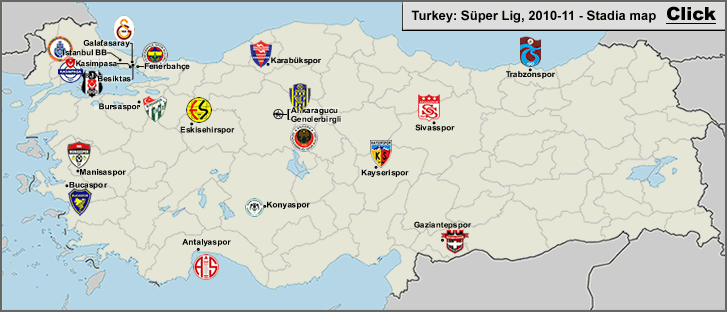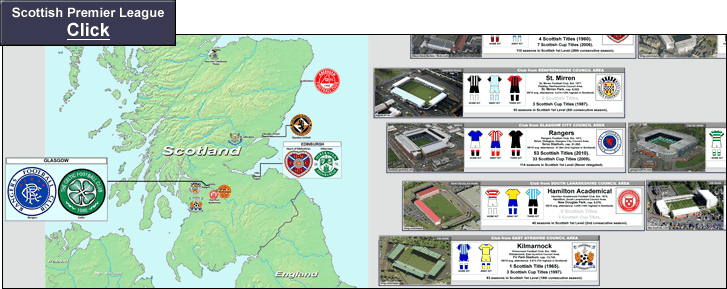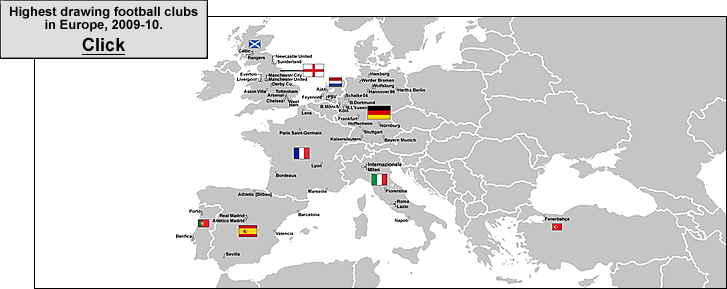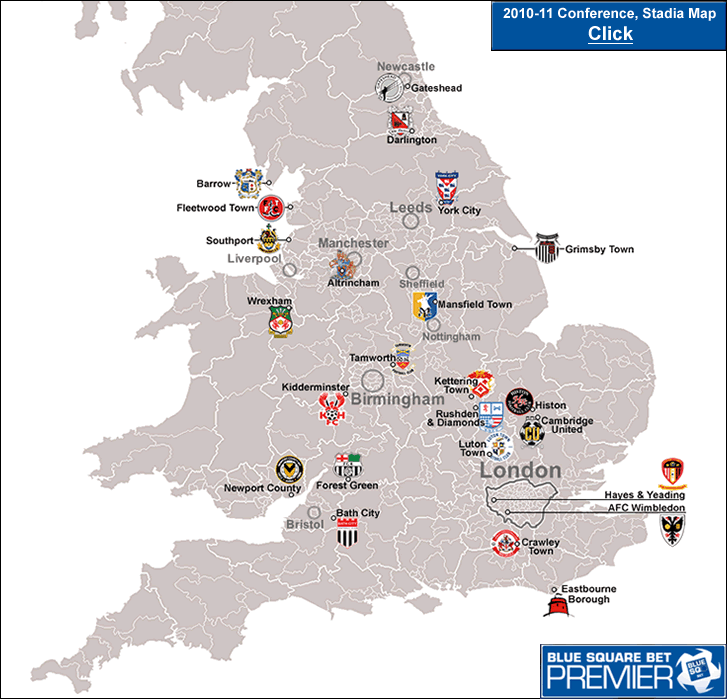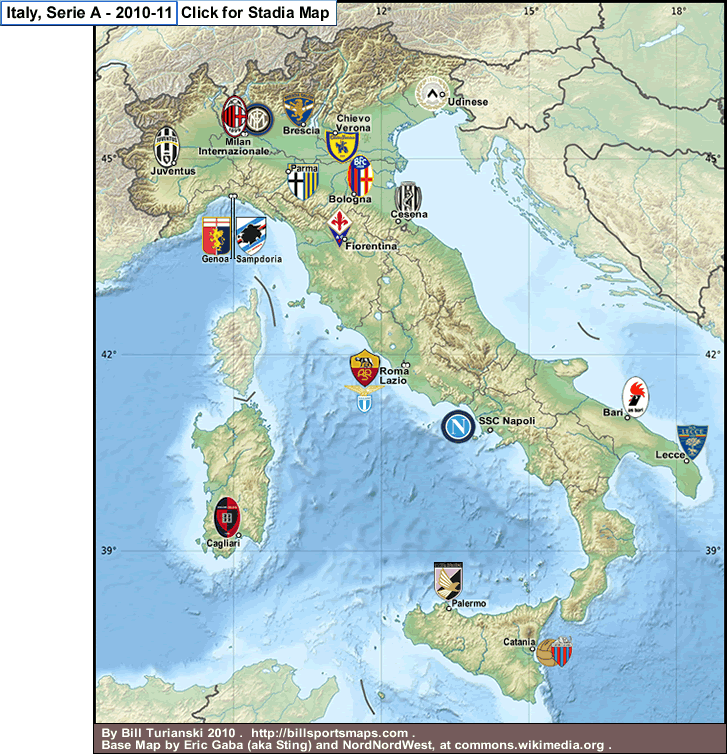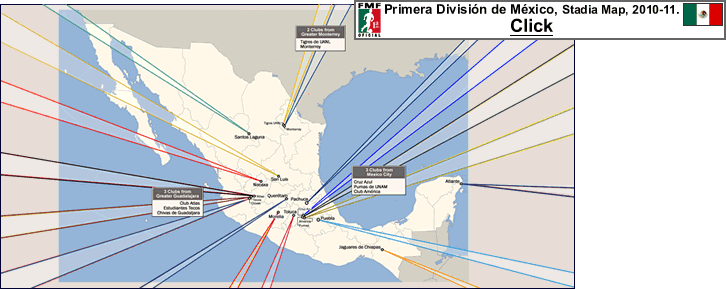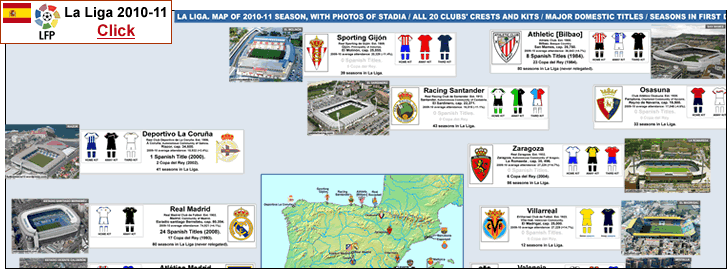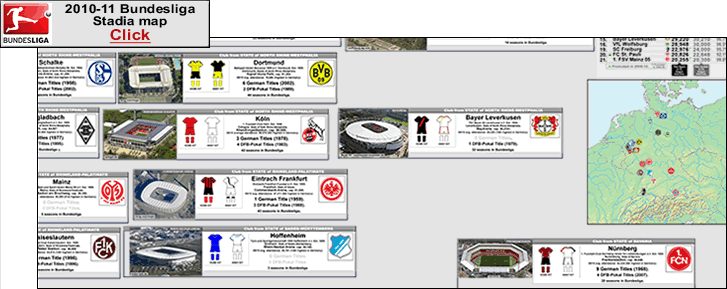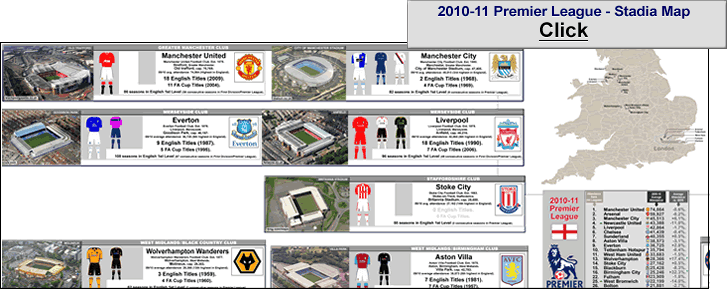…
…
The map page shows stadia and club information for the 18 clubs in the 2010-11 Süper Lig. Reigning Turkish champions are Bursaspor, and 2009-2010 Turkiye Kupasi winners and cup holders are Trabzonspor. At the upper right on the map page is the all-time professional titles list for Turkey. Tied for first place, with 17 titles, are Istanbul’s Galatasaray (last title won in 2008) and Fenerbahçe (last title won in 2007); third with 13 titles are Istanbul’s Besiktas (last title won in 2009); fourth are Trabzon-based Trabzonspor, with 6 titles (last title won in 1984); fifth are Bursa-based Bursaspor.
On Sunday, 16 May 2010, for the fist time in 26 years, a football club from outside Istanbul won the Turkish championship. Bursaspor, known as the Green Crocodiles, are from Bursa, which is about 15 km. south of the Sea of Marmara in north-western Anatolia. Bursa is the fourth-largest city in Turkey, with a population of around 1.8 million {2008 census figures}. Bursaspor were formed in 1963 and first made it into the Turkish first division in 1967-68. Although Burasaspor have spent 42 seasons in the first division, they had never really challenged for the title. Before last season, Bursaspor’s best finish was in 1979-80, when they finished in 4th place, 6 points behind winners Trabzonspor. In fact, Bursaspor were recently relegated, in 2003-04 (they won promotion back to Süper Lig two seasons later, in 2005-06). The fallout from that relegation is still felt in the Turkish football scene, as it created a bitter rivalry between Bursaspor and Besiktas…that is explained in this recent article from the brilliant site European Football Weekends: ‘Turkish eye of the storm, Besiktas 1-0 Bursaspo (05:11:10)‘, by Ulas Gürsat.
Bursaspor has become a club that is able to develop good talent while operating on a budget which is a fraction of those of the Big 3 (of Fenerbahçe, Galatasaray, and Besiktas). Last season, Bursaspor had a budget of around just 5.5 million pounds, versus Fenerbahce’s 65-million pound budget, and Galatasaray’s 41-million pound outlay. The Green Crocodiles squad plays open attacking football under young (41 yrs. old) manager Ertugrul Saglam, who resurrected his career after his stint managing his old club Besiktas in 2007-08, which included a tepid 3rd-place league finish and an embarrassing 8-0 loss to Liverpool in the 2007-08 Champions League Group Stage. Bursaspor had no standout leading scorer in their title run in 2009-10, instead fielding 4 players (shown below) who scored 7 or 8 league goals. And they were able to succeed without their talismanic young phenom, the supporting striker Sercan Yildrim, who was injured for over half of the campaign. Perhaps the other most promising player in the squad is LW/MF Ozan Ípek…’Ozan Ipek – A Turkish box-to-box midfielder with a big future‘, (IMS Scoutng.com).
On the last day of the 2009-10 season, Bursaspor squeaked in for the title, by one point, after they beat Besiktas 2-1, while Fenerbahçe only managed to draw 1-1 with Trabzonspor. Fenerbahçe fans at the Sükrü Saracoglu stadium in Istanbul actually thought their club was set to win the title after the stadium announcer gave the wrong score for the match at Bursa. I bet there were a lot of Galatasaray fans that got a good laugh out of that screw-up. Here is an article from 17th May, from the National Turk.com site, ‘Fenerbahce crushed as Bursa declared Champions of Turkey’.
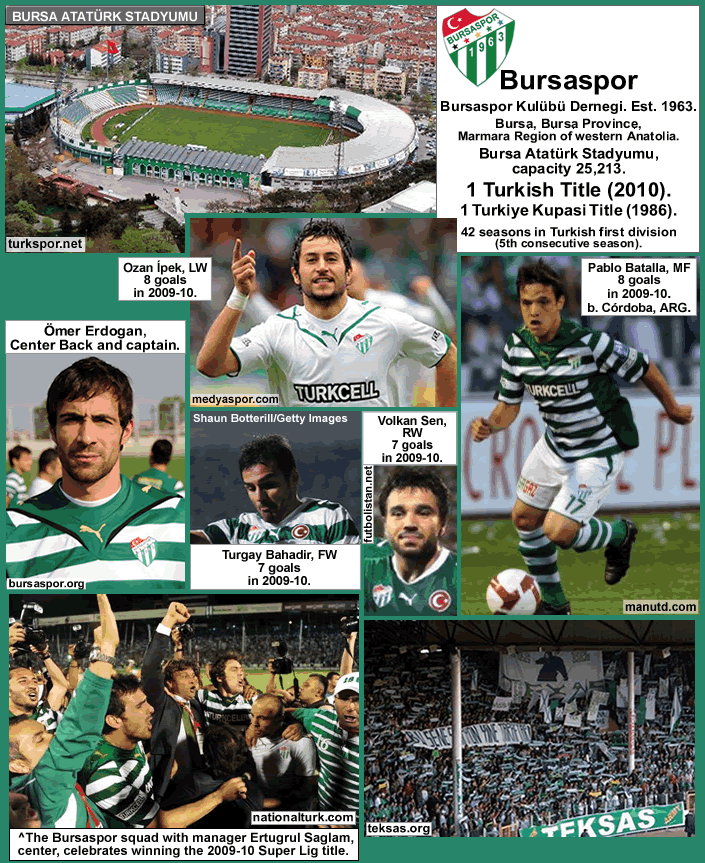
photo credits – Turkcell.net for the Bursa Atatürk Stadyumu photo, here.
Bursaspor.org. Medyaspor.com. ManUtd.com. Shaun Botterill/Getty images at Zimbio.com [CL match of Bursa v. Manchester United]. Futbolistan.com. National Turk.com, article ‘ Fenerbahce crushed as Bursa declared Champions of Turkey’ (17 May , 2010)‘.
Teksas.org [Bursaspor fansite].
…
Census-defined regions of Turkey, see this.
‘List of cities in Turkey [note: by city population only (no metropolitan-area population included]‘ from en.wikipedia.org.
On the chart below, 2008 census figures are used, and all cities with Turkish top-flight representation are listed in bold…
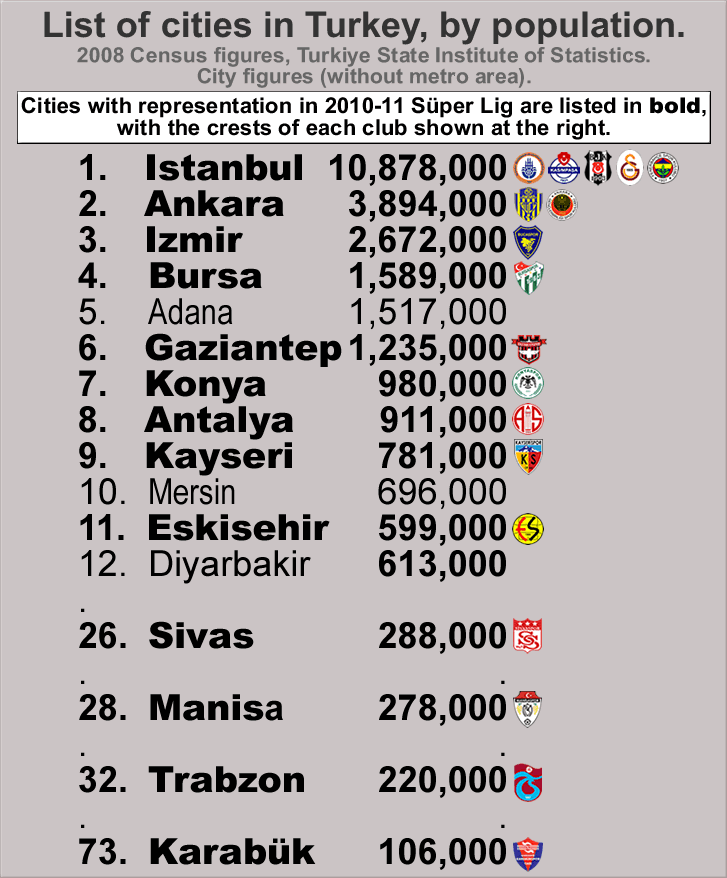
…
This season, there could very well be another champion from outside Istanbul, as Trabzonspor lead by 5 points, with Bursaspor in second place. The north-eastern Anatolian club Trabzonspor come from the pretty small Black Sea coastal city of Trabzon {which has a city population of around 220,000}. 6-time champions Trabzonspor had their glory days in the late 1970s and early 1980s, and the club has not won the title since 1984. It’s starting to look like only 2 of the Big 3 will have a chance for the crown, because Galatasaray are imploding (winning only 1 of their last 6 matches), and they sit 10th, 19 points off the pace. Fenerbahçe sit third, 9 points back. Central Anatolian club Kayserispor are in fourth, 10 points back. Besiktas are fifth, 12 points behind.
Turkish Süper Lig table, here (Soccerway.com).
 .
.
Photo credits – internetspor.com. yorumla.net.
Süper Lig will begin its 5-week-long winter break after the matches scheduled for the weekend of 17 to 19 December. The competition will then be at exactly the half-way point, with clubs having played 17 matches. Play will resume starting on 22 January, 2011.
Note: Galatasaray have not yet begun playing in their just-completed, new, 52,000-seat stadium. It looks like they will begin playing there sometime in late January or early Februaury, 2010. Here is a recent thread (posts from the first week in December, and with lots of photos) from Skyscrapercity.com, ‘ISTANBUL – Turk Telecom Arena (52,695)‘.
-
Thanks to Mehmet Demircan at World Soccer, June 2010 issue. WorldSoccer.com.
Photo credits
Thanks to the Gaziantepsor official site, for the photo of their stadium, here (Gaziantep Kamil Ocak Stayumu gallery).
Thanks to Kamil Saim, for his photo of the Kader Has Stadium, which is the new municipal stadium in Kayseri, in Central Anatolia. The term municipal stadium doesn’t do this impressive structure justice here. Kamil Saim at Flickr.com.
Thanks to Konyaspor official site, for the photo of their stadium, here (Konya Attatürk Stadi gallery).
Thanks to leopold at Photobucket.com, for the photo of the new Maradan Sports Complex in Atalya, here.
Thanks to Milliyet.com.tr, for the photo of Bucaspor’s Yeni Buca Stadi, here.
Thanks to Fussball Tempel.net, for the Manisa 19 Mayis Stadi photo, here (gallery).
Thanks to Swatreco at the Skyscrapercity.com thread ‘Stadiums in Turkey,’for the Ankara 19 Mayis Stadi photo, here (40% down the page).
Thanks to Turkcell.net (this article), for the Bursa Atatürk Stadyumu photo, here.
Thanks to Nerdennereye.com, for the Sivas 4 Eylül Stadyumu photo, here (Sivas photo gallery).
Thanks to Karabuksporluyuz.com/forum, and contributor bahattinsenturk, for the photo of Yenişehir Stadyumu, here.
Thanks to TFF.org, for the photo of the recently renovated Hüseyin Avmi Aker Stadyumu – Trabzonspor/Hüseyín Avní Aker Stadyumyu.
Thanks to blackbir/dk, for his photo of Istanbul’s Atatürk Olímpíyat Stadi, here (at Flickr.com). Blackbir/dk’s photostream, here.
Thanks to adamsik, for the photo of Kasimpasa’s Recep Tayyip Erdogan Stadi, here.
Thanks to Explore Istanbul.com, for the photo of Besiktas’ Ínönü Stadyumu, here.
Thanks to Skyscrapercity.com contributor www.sercan.de, for the photo (via Flickr.com) of Galatasaray’s Ali Sami Yen Stadi, here. The thread is here, ‘Stadium Aerials’…the page linked to starts with 3 photos of Fenerbahce’s Sükrü Saracoglü Stadi, then 3 photos of Besiktas’ Inönü Stadyumu, then the Galatasaray photo.
Thanks to ZeroZeroFootball.com, for the nighttime photo of Fenerbahçe’s Sükrü Saracoglu Stadyumu, here…[Note: the photo is credited to the WowTurkey.com site, but I could not find the original there. The following links are to the WowTurkey site’s ‘Fenerbahçe Sükrü Saracoglu Stadyumu’ thread, here, with lots of pages full of stadium photos, including shorts from a few years back when the stadium had only 3 sides re-built (~pp.6-9, here), and shots of the exterior lighting display (pp.17-18, here).
Thanks to the contributors to the pages at en.wikipedia.org, ‘Süper Lig‘.
